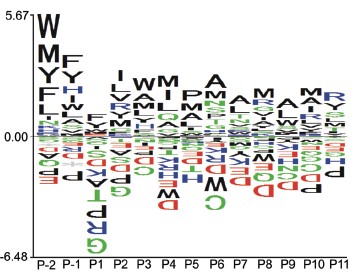| [1] ten Broeke, T.; van Niel, G.; Wauben, M. H.; Wubbolts, R. Traffic. 2011, 12(8), 1025. [2] Crotzer, V. L.; Blum, J. S. J. Immunol. 2009, 182(6), 3335. [3] Neefjes, J.; Jongsma, M. L.; Paul, P.; Bakke, O. Nat. Rev. Immunol. 2011, 11(12), 823. [4] Ferrante, A.; Gorski, J. J. Immunol. 2007, 178(11), 7181. [5] Agudelo, W. A.; Patarroyo, M. E. Mini-Rev. Med. Chem. 2010, 10(8), 746. [6] Wang, R. F.; Wang, X.; Rosenberg, S. A. J. Exp. Med. 1999, 189(10), 1659. [7] Madden, D. R. Annu. Rev. Immunol. 1995, 13, 587. [8] Zhu, Y. R.; Rudensky, A. Y.; Corper, A. L.; Teyton, L.; Wilson, I. A. J. Mol. Biol. 2003, 326(4), 1157. [9] Bian, H. J.; Hammer, J. Methods 2004, 34(4), 468. [10] Bian, H. J.; Reidhaar-Olson, J. F.; Hammer, J. Methods 2003, 29(3), 299. [11] Jardetzky, T. S.; Brown, J. H.; Gorga, J. C.; Stern, L. J.; Urban, R. G.; Strominger, J. L.; Wiley, D. C. Proc. Natl. Acad. Sci. U. S. A. 1996, 93(2), 734. [12] Zavala-Ruiz, Z.; Strug, I.; Anderson, M. W.; Gorski, J.; Stern, L. J. Chem. Biol. 2004, 11(10), 1395. [13] Bui, H. H.; Sidney, J.; Peters, B.; Sathiamurthy, M.; Sinichi, A.; Purton, K. A.; Mothe, B. R.; Chisari, F. V.; Watkins, D. I.; Sette, A. Immunogenetics 2005, 57(5), 304. [14] Nielsen, M.; Lundegaard, C.; Lund, O. BMC Bioinformatics 2007, 8, 238. [15] Brusic, V.; Rudy, G.; Honeyman, G.; Hammer, J.; Harrison, L. Bioinformatics 1998, 14(2), 121. [16] Lata, S.; Bhasin, M.; Raghava, G. P. S. Methods Mol. Biol. 2007, 409, 201. [17] Chang, S. T.; Ghosh, D.; Kirschner, D. E.; Linderman, J. J. Bioinformatics 2006, 22(22), 2761. [18] Doytchinova, I. A.; Flower, D. R. Bioinformatics 2003, 19(17), 2263. [19] Wang, P.; Sidney, J.; Dow, C.; Mothe, B.; Sette, A.; Peters, B. PLoS Comput. Biol. 2008, 4(4), e1000048. [20] Rammensee, H. G.; Friede, T.; Stevanovic, S. Immunogenetics 1995, 41(4), 178. [21] Chang, C. C.; Lin, C. J. ACM. TIST. 2011, 2(3), 1. [22] Liu, T.; Liu, W.; Song, Z.; Jiao, C. B.; Zhu, M. H.; Wang, X. G. Cell. Mol. Immunol. 2009, 6(2), 135. [23] Lopez, J.; Suykens, J. A. Neural. Process. Lett. 2011, 33(1), 31. [24] Perez-Garrido, A.; Helguera, A. M.; Borges, F.; Cordeiro, M. N.; Rivero, V.; Edcudero, A. G. J. Chem. Inf. Model. 2011, 51(10), 2746. [25] Dong, S. M.; Song, Z.; Liu, T.; Zhu, M. H.; Liu, W. Acta Chim. Sinica 2010, 68(18), 1821. (董素梅, 宋哲, 刘涛, 朱鸣华, 刘伟, 化学学报, 2010, 68(18), 1821.) [26] Nielsen, M.; Lundegaard, C.; Blicher, T.; Peters, B.; Sette, A.; Justesen, S.; Buus, S.; Lund, O. PLoS Comput. Biol. 2008, 4(7), e1000107. [27] Altuvia, Y.; Margalit, H. Methods 2004, 34(4), 454. [28] Song, Z.; Liu, T.; Jiao, C. B.; Liu, W.; Zhu, M. H.; Guo, Y. F.; Wang, X. G. Sci. China Ser. B-Chem. 2009, 52(1), 39. [29] Cardenas, C.; Ortiz, M.; Balbin, A.; Villaveces, J. L.; Patarroyo, M. E. Biochem. Biophys. Res. Commun. 2005, 330(4), 1162. [30] Sundberg, E. J.; Sawicki, M. W.; Southwood, S.; Andersen, P. S.; Sette, A.; Mariuzza, R. A. J. Mol. Biol. 2002, 319(2), 449. [31] Busch, R.; Hill, C. M.; Hayball, J. D.; Lamb, J. R.; Rothbard, J. B. J. Immunol. 1991, 147(4), 1292. [32] Murthy, V. L.; Stern, L. J. Structure 1997, 5(10), 1385. [33] Vargas, L. E.; Parra, C. A.; Salazar, L. M.; Guzman, F.; Pinto, M.; Patarroyo, M. E. Biochem. Biophys. Res. Commun. 2003, 307(1), 148. [34] Fremont, D. H.; Hendrickson, W. A.; Marrack, P.; Kappler, J. Science 1996, 272(5264), 1001. [35] Wilson, N.; Fremont, D.; Marrack, P.; Kappler, J. Immunity 2001, 14(5), 513. Cardenas, C.; Villaveces, J. L.; Bohorquez, H.; Llanos, E.; Suarez, C.; Obregon, M.; Patarroyo, M. E. Biochem. Biophys. Res. Commun. 2004, 323(4), 1265. |
